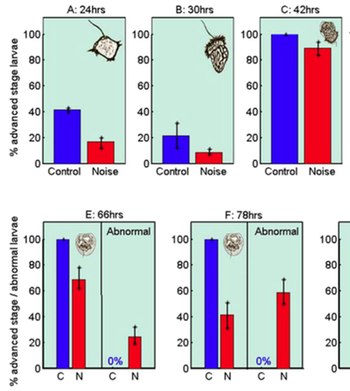Ocean noise may disrupt larval development
Effects of Noise on Wildlife, Ocean, Seismic Surveys Add commentsAEI lay summary of:
Natasha Aguilar de Soto, Natali Delorme, John Atkins, Sunkita Howard, James Williams, Mark Johnson. Anthropogenic noise causes body malformations and delays development in marine larvae. Nature Scientific Reports, 3:2831. DOI: 10.1038/srep02831 Download PDF
Just months after shipping noise was shown to cause dramatic behavioral changes in crabs, this new paper provides the first evidence that low-frequency seismic airgun sounds may trigger developmental delays and malformation in the larvae of shellfish. Over the past decade or so, as researchers have looked more closely at behavioral disruptions caused by human noise sources, including temporary displacement of some fish stocks away from seismic surveys, there has been some concern that acute noise exposure from high-intensity sound sources such as airguns could also affect larval development. If this were shown to be so, then regulators may need to consider protecting some vulnerable areas from intense noise exposure during seasons of key larval development.
This study exposed scallop larvae to recorded sounds of airgus, and compared larval development beginning after 24 hours of sound exposure and continuing until 90 hours. This encompassed several stages of larval development, with 470-800 larvae examined at each sampling time.
 For the first day and a half, larvae exposed to airgun noise showed significant developmental delays. At close to two days, the noise-exposed group appeared to be nearly as likely to be fully developed as the control group (upper right chart). But, after passing the 48-hour mark, as the larvae moved into the next stage of development, those in noise lagged again; at 66 hours, all of the control larvae had completed the D-veligar development, while a large proportion of those exposed to noise did not complete this transition. In addition, a significant proportion of the noise-exposed larvae began exhibiting physical abnormalities (localized bulges in the soft body of the larvae, but not in the shell). By the end of the study, at 90 hours, an average of 46% of noise-exposed larvae showed malformations, ranging from 27%-91% in the four flasks being independently analyzed. (Ed. Note: I’ve reproduced five of the seven charts here, omitting samplings at 54hrs and 90hrs for the sake of better readability.)
For the first day and a half, larvae exposed to airgun noise showed significant developmental delays. At close to two days, the noise-exposed group appeared to be nearly as likely to be fully developed as the control group (upper right chart). But, after passing the 48-hour mark, as the larvae moved into the next stage of development, those in noise lagged again; at 66 hours, all of the control larvae had completed the D-veligar development, while a large proportion of those exposed to noise did not complete this transition. In addition, a significant proportion of the noise-exposed larvae began exhibiting physical abnormalities (localized bulges in the soft body of the larvae, but not in the shell). By the end of the study, at 90 hours, an average of 46% of noise-exposed larvae showed malformations, ranging from 27%-91% in the four flasks being independently analyzed. (Ed. Note: I’ve reproduced five of the seven charts here, omitting samplings at 54hrs and 90hrs for the sake of better readability.)
The authors note that “the abnormalities observed here are comparable to those caused by chemical pollutants or water acidification, which have a clear impact on larval survival.” They suggest several possible mechanisms for the abnormal bulges observed, and conclude that “although the exact mechanism is far from evident, physiological stress is likely the mediator for the developmental delays and growth abnormalities reported here.” Further, the authors note that while behavioral responses vary widely both among and within species, stress response mechanisms are more generally similar across taxa, “suggesting that other invertebrates with similar growth patterns may be similarly affected.”
Of course, the nature of sound exposures in the ocean will be markedly different than those in this laboratory experiment, in which larvae were repeatedly exposed to a steady stream of 160dBrms impulses, once every three seconds for 24-90 hours. In particular, the authors suggest that particle motion, rather than sound pressure, is the likely trigger for the effects, and acknowledge that several factors make it difficult to accurately predict the impact zone around an airgun in which particle motion would approach the 4-6mm/s RMS experienced by the sound-exposed larvae here. In addition, the long periods of continuous exposure used in this testing procedure, while necessary in order to determine if there were indeed clear dose-response effects, may not be widely replicated in the wild. Accordingly, the authors recommend that future research aim to establish the thresholds of exposure levels and durations that cause the effects seen here.
However, the authors stress that “given the strong disruption of larval development reported here, weaker but still significant effects can be expected at lower exposure levels and shorter exposure durations, especially if some ontogenetic stages such as the D-veliger prove to be particularly sensitive.”
